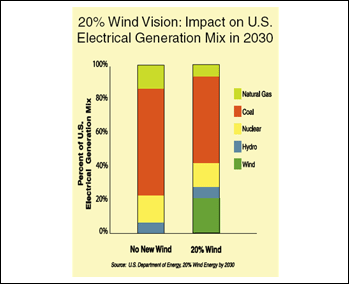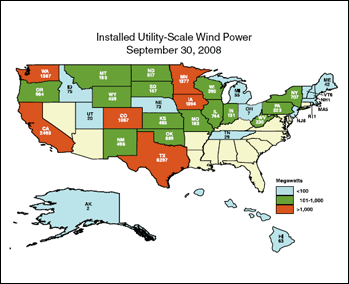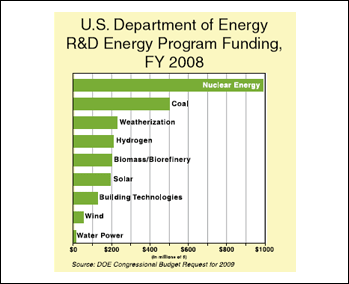| Back in the 1960s, Bob Dylan’s song melodiously and metaphorically suggested that the wind would reveal the solutions for the nation’s social ills. Almost five decades later, wind power is poised to be one “answer” to the U.S. need for both clean, renewable, affordable energy sources and job growth in a country too often held hostage by fossil fuel price fluctuations. |
| |
| In May 2008, the U.S. Department of Energy (DOE) published its 20% Wind Energy by 2030 report which examines one scenario–supplying 20% of the country’s electrical demand via wind energy by 2030–and contrasts it to a scenario in which no new U.S. wind power capacity is installed. (See graph below.) |
| |
 |
| [Place cursor over graph to enlarge] |
| |
| The findings: achieving the 20% goal substantially cuts CO2 emissions, reduces electricity costs, creates long-term price stability, promotes energy independence, and would support 500,000 green jobs. |
| |
| Wind Power Growth |
| |
| According to the American Wind Energy Association (AWEA), wind power accounted for nearly 35% of all new electricity generating capacity added in the U.S. in 2007, up from less than 1% in 2002. In 2008, the U.S. became the largest generator of wind power in the world, powering more than 5.7 million homes. By the end of September 2008, a total of 21,017 megawatts (MW) of wind power was installed in 35 states. (See map below.) |
| |
 |
| [Place cursor over map to enlarge] |
| |
| In addition, more than 50 wind industry manufacturing plants have been opened or announced since 2007, creating thousands of American jobs in a manufacturing sector plagued with layoffs. |
| |
| Wind Power Obstacles |
| |
| The economic driver behind the growth of the wind industry has been the federal incentives provided to wind companies |
| |
|
|
| and investors by the renewable energy production tax credit (PTC), a credit of 2.1 cents per kilowatt hour. Two major problems exist with the PTC program. First, it offers little benefit to investors in a down market where demand for a tax credit is limited. Second, the PTC has only been extended for one- or two-year terms since 1999, discouraging companies from making long-range, large investments in wind power manufacturing and development. |
| |
| During his presidential campaign, Barack Obama promised to implement a minimum five-year PTC extension during his administration to facilitate wind power production. |
| |
| Perhaps the biggest hurdle facing the wind power industry is the lack of available transmission–the infrastructure needed to deliver electricity from the rural, windy areas where it is generated to the heavily populated areas where it is used. The DOE’s 20% report recommends an increase in annual federal funding from $8 to $11 billion to construct a high-voltage green transmission system. |
| |
| Building a transmission system to harness wind power may become a secondary priority, however. According to T. Boone Pickens (Texas tycoon who plans to invest billions in wind farm construction), the nation’s aging, fragmented and inefficient electrical grid needs a complete overhaul. The Brattle Group, a think tank that does extensive research in the energy sector, released its projection in November 2008: The U.S. utility system needs to invest a staggering $1.5 to $2.0 trillion between 2010 and 2030 to maintain just the current levels of reliable energy service and introduce “smart grid” technologies to integrate all sources of electricity. |
| |
| Federal Funding and Future |
| |
| Overall, 2008 federal funding for wind energy research and development (R&D) was dwarfed by allocations to other energy programs. (See graph below.) |
| |
 |
| [Place cursor over graph to enlarge] |
| |
| The DOE recommends that Congress should increase the annual federal funding for wind energy R&D from its 2008 $50 million level to $217 million, to be phased in over the next three to five years. |
| |
| Obama made energy independence a top priority in his campaign platform. The Obama-Biden New Energy for America Plan states it “will ensure that 10% of our electricity comes from renewable sources by 2012, and 25% by 2025.” Obama also emphatically vowed: “I will set a clear goal as president: In ten years, we will finally end our dependence on oil from the Middle East.” |
| |
The next four years will determine if the energy policies of the Obama administration are committed to harnessing the power found “blowin' in the wind,” or if they are just
blowin’ smoke. |
|